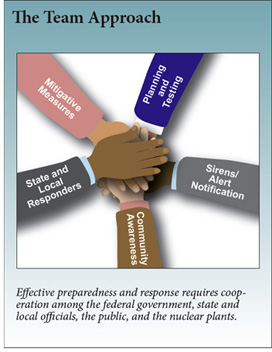 Preparedness and Response Preparedness and Response
No matter how small the risk, the NRC requires all nuclear power plants to have and periodically test emergency plans that are coordinated with federal, state and local responders. The goal of preparedness is to reduce the risk to the public during an emergency.
In an emergency, the NRC and the licensee would activate their Incident Response Programs. Licensee specialists would evaluate the situation and identify ways to end the emergency, while the NRC would monitor the event closely, keeping government offices informed. If a radiation release occurred, the plant would make protective action recommendations to state and local officials, such as evacuating areas around the plant.
Each nuclear power plant has two EPZs. Each EPZ considers the specific conditions and geography at the site, and the community. The first is the Plume Exposure Pathway EPZ, which has a radius of about 10 miles from the reactor. People living there may be asked to evacuate or “shelter in place” during an emergency, to avoid or reduce their radiation dose. The second is the Ingestion Exposure Pathway EPZ. This has a radius of about 50 miles from the reactor. Protective action plans for this area aim to avoid or reduce the radiation dose from consuming contaminated food and water.
|
